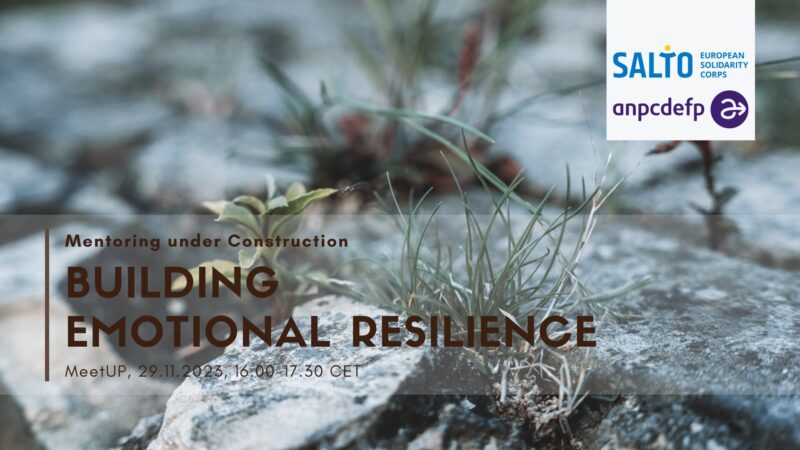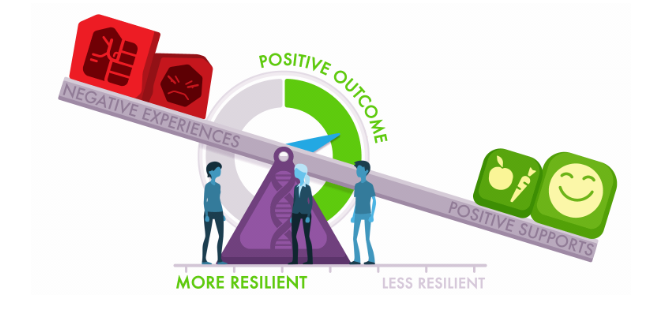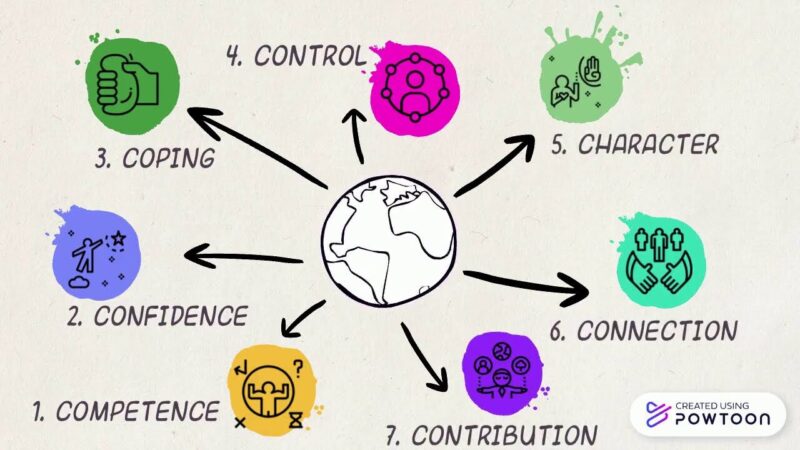Building Emotional Resilience | Mentoring under Construction

The content of this blog post has been created in the context of Mentoring under Construction. Mentoring under Construction is a community for mentoring practitioners within the European Solidarity Corps programme.
Volunteers and colleagues, friends and families, but also we experience difficult moments in life, face challenges, get stuck and struggle in moving forward. In such moments it is crucial to be well-equipped and resourceful to cope with them in order to get unstuck, go ahead and thrive again. Key to this is building emotional resilience, the ability to “bounce back’.
What is resilience
“Even the tiniest of flowers can have the toughest roots.”
Shannon M. Mullen, See What Flowers
What’s resilience to you? – Take a moment before you go through this text. Think about it, visualise it, write down a couple of lines.
Activity: Objects that symbolize resilience
Get up, leave the screen and look around in your flat, grab an object that symbolises resilience for you. Write down a couple of its features. Now, check out our padlet „Grab an object that symbolises resilience for you!” and see how other people describe resilience.
![Resilience [obejcts]](https://michaelkimmig.eu/wp-content/uploads/2023/12/Resilience-obejcts-980x420.jpg)
Here are some of the results…
keeping record of my thoughts with journaling – sharing my emotions with others – surviving and thriving in a different environment – keeping myself together – get myself back in shape – facing challenges – emotional support – being able to meet your feelings and emotions, recognize and respect them, listen to the message from them – one drop per day can bring resilience over time – developing constant habits and routine – think positive – recharging batteries – take some time for myself – listen to music – get perspective
Now, let’s check out some theory and research…
What is emotional resilience
![Resilience [definition]](https://michaelkimmig.eu/wp-content/uploads/2023/12/Resilience-definition.png)
Resilience
Resilience goes back to the latin word ‘resilire’, which means ‘to jump back” or “to recoil’. According to the Merriam Webster Dictionary Resilience is “an ability to recover from or adjust easily to misfortune or change”.
The American Psychological Association defines resilience as “the process of adapting well in the face of adversity, trauma, tragedy, threats, or significant sources of stress — such as family and relationship problems, serious health problems, or workplace and financial stressors.”
Elements of resilience
The word resilience is often used on its own to represent overall adaptability and coping, but it can be broken down into three categories. Madhuleena Roy Chowdhury (What Is Emotional Resilience? via PositivePsychology.com) defines various elements of resilience:
- Psychological (or mental) resilience includes aspects like adaptability, attention and focus, self-esteem, self-confidence, emotional awareness and regulation, self-expression, mental toughness, thinking, and reasoning abilities.
- Physical resilience involves physical strength, energy, good health, and vitality.
- Social (or community) resilience refers to interpersonal relationships (work, partner, kids, parents, friends, community, etc), group conformity, likeability, communication and co-operation.
Emotional resilience
Emotional resilience refers to an individual’s ability to adapt and bounce back from difficult or emotionally challenging experiences. It’s the capacity to withstand adversity, cope with stress, and maintain psychological well-being even in the face of life’s ups and downs. Emotional resilience doesn’t mean avoiding or suppressing emotions but rather managing and learning from them constructively.
Resilience refers both to ‘bouncing back’ from stressful and difficult life experiences and at the same time it means personal development and growth.
The resilience scale metaphor
The resilience scale shows that resilience is not a personality trait that determined by our genes but an outcome of a complex interplay of life experiences, coping skills and personality traits.

Risk and protective factors
The left side of the scale gets loaded up with negative experiences, so called risk factors that tip the scale in a negative direction. Positive experiences – protective factors – are stacked on the other side and tip the scale in a positive direction.
The position of the falcrum
Positive and negative experience alone do not determine weather our resilience scale weights to one or to the other side. For everyone of us, the position of the fulcrum – the balance point of the scale – lies more to the right or to the left: some of us react more sensitive to the effects of toxic stress, while others seem to prosper more from protective factors than others.
Moving the position of fulcrum
The position of the fulcrum is something that can change. Over time positive experiences at critical stages of development can shift the fulcrum in a more resilient direction so that we are better prepared to bounce back from stressful life events.
Three principles to build resilience
Having the resilience scale metaphor in mind, there are three principles to build resilience: Increasing positive and minimizing negative experience as well as developing core skills that strengthen the coping skills and personality. For kids and youth, especially supporting responsive relationships, relationships that help in building resilience across the lifespan are essential for the development of resilience. Reducing sources of stress, e.g. by minimizing negative experience, protect young people from building up toxic stress. And last, but not least strengthening core life skills shift the balance point – the fulcrum – of the scale.
If you want to know more about how these three principles work out, read: How to Help Families and Staff Build Resilience During the COVID-19 Outbreak, by the Center on the Developing Child at Harvard University.
How to build resilience
“Do not judge me by my success, judge me by how many times I fell down and got back up again.”
― Nelson Mandela
Searching for activities and techniques to develop emotional resilience seems easy. Due to the broad concept of emotional resilience and the fact that it touches on various concepts you may find endless lists of activities and methods. In order to find a starting point, it is helpful to know some models that identify certain areas which you might want to focus on.
The resilience scale already introduced three main principles that contribute building resilience: supporting relationships, reducing sources of stress and strengthening core life skills.
The American Psychological Association (APA) identifies four strategies to build resilience (Building your resilienceby American Psychological Association):
- Foster wellness
- Embrace healthy thoughts
- Building relationships
- Find purpose
Cary Cooper with his team identified four elements of resilience (Building Resilience for Success, 2013 by Cary Cooper, Jill Flint-Taylor, and Michael Pearn):
- Confidence,
- Social support,
- Adaptability and
- Purposefulness
MindTools provide a short, illustrative test based on those four elements of resilience . For each of this elements they provide further readings.
For many people, using those strategies and their own resources may be enough for building their resilience. However, in difficult situations, when you are stuck or struggle making progress it is crucial to reach out for professional help.
Building resilience: The 7 Cs of Resilience
Ken Ginsburg developed a model to support kids and youth building the skills to strengthen well-being and resilience. The 2 Cs of Resilience were first published by the American Academy of Pediatrics in 2006 and provide a framework for resilience-building skills and strategies that parents, schools, communities, youth programs, and professionals can use to support youth. They illustrate the interplay between personal strengths and outside resources.

The American Academy of Pediatrics summarizes the 7 Cs as follows:
- Competence – This is the ability to know how to handle situations effectively. To build competence, individuals develop a set of skills to help them trust their judgments and make responsible choices.
- Confidence – True self-confidence is rooted in competence. Individuals gain confidence by demonstrating competence in real-life situations.
- Connection – Close ties to family, friends, and community provide a sense of security and belonging.
- Character – Individuals need a fundamental sense of right and wrong to make responsible choices, contribute to society, and experience self-worth.
- Contribution – Having a sense of purpose is a powerful motivator. Contributing to one’s community reinforces positive reciprocal relationships.
- Coping – When people learn to cope with stress effectively, they are better prepared to handle adversity and setbacks.
- Control – Developing an understanding of internal control helps individuals act as problem-solvers instead of victims of circumstance. When individuals learn that they can control the outcomes of their decisions, they are more likely to view themselves as capable and confident.
Source: What Is Resilience? Your Guide to Facing Life’s Challenges, Adversities, and Crises by Katie Hurley via everydayhealth.com
Here is a short video: The 7 Cs of Resilience by RESET (reset-eu.net)
Activity: Develop your resilience skills
Review the resilience skills and strategies you currently use:
- Which resilience skills and strategies are you using?
- What works well?
Identify 1-2 resilience skill you would like to develop:
- Which resilience skills you would like to develop (more)?
Decide on 1 goal and 2 steps:
- Which resilience skill would you like to focus on in the next month?
- What 2 steps can you take to make this happen?
Resilience Building Activities
The variety of activities on building resilience reach from self-tests, reflection techniques, journaling, practicing meditation, gratitude or random acts of kindness, activities on mental strength and toughness.
Before jumping into this broad variety of activities and techniques, you may want to take a test in order to find out on what exactly to focus if you want to further develop your emotional resilience. Some useful tests and scales you may find here: What Is Emotional Resilience? via PositivePsychology.com.
You find a selection of activities in Karen Doll’s article 23 Resilience Building Activities & Exercises for Adults.
Reflection: Resilience Renewal Practice
If something doesn’t go your way, how do you reset? If you are upset, angry, hurt, frustrated, etc. what do you do? When emotion strikes, what is your routine/practice to get back on track?
2 Step-Reflection
1. Reflect and acknowledge: What happened? Where does this come from?
2. Set an Intention: With what do I want to move forward with?
Recommended Resources
Resilience
What Is Resilience? Your Guide to Facing Life’s Challenges, Adversities, and Crises by Katie Hurley via everydayhealth.com
What Is Emotional Resilience? (+6 Proven Ways to Build It) by Madhuleena Roy Chowdhury via PositivePsychology.com
Resilience Scale
Resilience. Why do some of us bounce back from adversity better than others? Via albertafamilywellness.org
How to Help Families and Staff Build Resilience During the COVID-19 Outbreak, The Center on the Developing Child at Harvard University
Building resilience
Building your resilience by American Psychological Association
Building Resilience: The 7 Cs (2018) by Ken Ginsburg via parentandteen.com
How Resilient Are You? Find Out How to Bounce Back From Problems by the Mind Tools Content Team
23 Resilience Building Activities & Exercises for Adults by Karen Doll via PositivePsychology.com
Resources
Resiliency Ohio. Supporting Mental Health in Ohio’s Youth. Resources
Resilience by American Psychological Association



